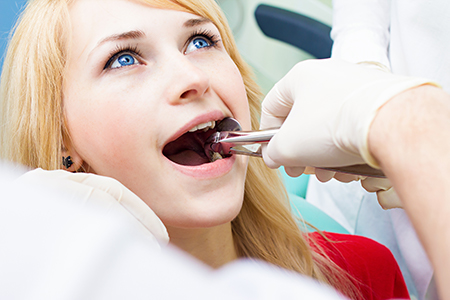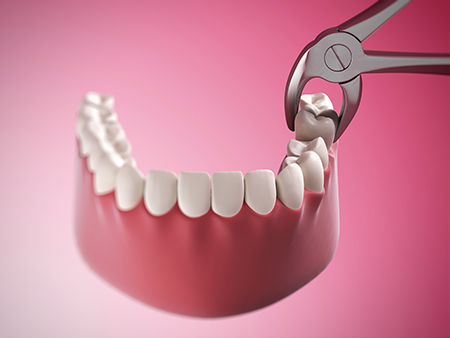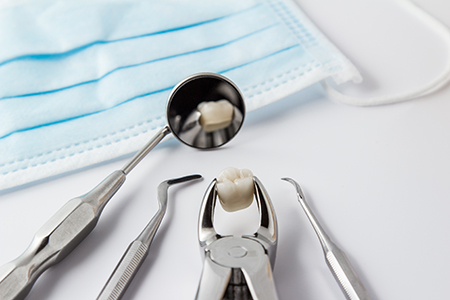Call Today
(908) 852-3693

Your comfort and long-term oral health guide every recommendation we make at the office of Dr. Anthony Iuvone, DMD. While preserving natural teeth is always the preferred path, there are circumstances in which removing a tooth is the best way to prevent further problems. Extractions can stop the spread of infection, relieve pain, protect neighboring teeth, and make space for proper alignment when needed.
We approach every extraction as a carefully planned procedure, not a hurried decision. Before recommending removal, we evaluate the tooth’s condition, review your overall medical history, and consider restorative alternatives. When extraction is the most responsible option, our goal is to provide the safest, most comfortable path to healing and recovery.
Patients in Hackettstown and the surrounding communities rely on our team for clear explanations and thoughtful care. We’ll walk you through the reasons for extraction, the different ways a tooth can be removed, and the steps you can expect before, during, and after the procedure.
Primary (baby) teeth that won't come out on schedule
Sometimes a primary tooth remains firmly attached while its permanent successor is ready to erupt. When a baby tooth fails to loosen because its root hasn't resorbed or it has become fused to the jaw, it can block normal eruption and affect bite development. Removing the retained tooth at the right time helps guide a child’s smile to form correctly.
Permanently damaged or decayed teeth that cannot be saved
When extensive decay, infection, or structural loss leaves little viable tooth to restore, extraction becomes a safer option than attempting repeated repairs. Removing a non-restorable tooth prevents ongoing infection and pain and creates an opportunity to plan for an appropriate replacement that preserves oral function.
Teeth compromised by severe fracture or root damage
Teeth that are broken below the gumline, fractured into multiple pieces, or have roots that are irreparably damaged may not respond well to crowns or other reconstruction. In those instances, careful removal minimizes the risk of further complications to adjacent tissues and makes way for future restorative options.
Advanced periodontal disease weakening root support
Periodontal (gum) disease is the leading cause of adult tooth loss. Once the bone and soft tissues that anchor a tooth are severely lost, the tooth can become loose and symptomatic. Extracting a failing tooth can halt the progression of infection and aid in preserving the health of remaining teeth.
Wisdom teeth that are impacted, poorly positioned, or at risk
Third molars often lack the space needed to erupt cleanly. Impacted or partially erupted wisdom teeth can trap food, harbor bacteria, and jeopardize neighboring teeth. Removing problematic third molars early, when appropriate, helps prevent chronic issues down the road.
Extractions to assist orthodontic treatment
In some orthodontic plans, removing specific permanent teeth creates the space necessary to align the bite and achieve a balanced, functional result. Extractions for orthodontic reasons are always coordinated with your orthodontic provider to ensure the best outcome for form and function.

Preparation begins with a thorough assessment. We review your medical history, current medications, and any conditions that could affect treatment. Digital radiographs are taken when indicated to evaluate root shape, position, and surrounding bone. This diagnostic step helps determine whether a straightforward removal is possible or if a surgical approach will be required.
Knowing your medical background allows us to take necessary precautions, such as coordinating with your physician or adjusting care for certain medications. We will explain anesthesia options—usually a local anesthetic for simple extractions, and additional sedation choices for patients with dental anxiety or complex surgical needs.
Our objective is to make the procedure predictable and as comfortable as possible. We will discuss each step so you know what to expect: how we’ll numb the area, the instruments we’ll use, estimated time in the chair, and any immediate aftercare measures you should follow.
A simple extraction applies when the tooth is fully visible in the mouth and has an uncomplicated root structure. After numbing the area with a local anesthetic, the dentist gently loosens periodontal fibers and uses extraction forceps to remove the tooth. This method is usually quick, and most patients experience minimal discomfort thanks to modern anesthetics and technique.
Surgical extractions are used for teeth that are broken, impacted, or fused to the jawbone. The dentist or an oral surgeon may make a small incision in the gum, remove a bit of bone if necessary, and section the tooth into pieces to remove it safely. Local anesthesia is provided, and additional sedation can be arranged when indicated. If a specialist is needed, we will coordinate that referral and share records to support continuity of care.

After an extraction the body begins a predictable healing process. Our post-operative guidance focuses on protecting the blood clot that forms in the socket, managing discomfort, and minimizing swelling. Following instructions closely reduces the risk of complications and speeds recovery so you can return to normal activities.
We provide personalized post-op directions that may vary according to the complexity of the extraction and your medical history. In general, the first 24–72 hours require the most careful attention to activity level, oral hygiene, and nutrition. A follow-up appointment may be scheduled to check healing and remove sutures if they were placed.
If you notice unusual symptoms—persistent heavy bleeding, escalating pain, fever, or a foul taste—contact our office so we can evaluate and provide appropriate care. Most routine healing follows an uncomplicated course when post-op instructions are observed.
Maintain gentle pressure with gauze
Immediately after your appointment, bite on the provided gauze to encourage clot formation. Replace the gauze as directed until bleeding diminishes. Some light oozing can persist for up to 24 hours, but sustained heavy bleeding warrants contact with the office.
Protect numb tissues
While local anesthesia is in effect, be careful not to chew or rest your lips, cheeks, or tongue between your teeth. Numbness can mask injuries, so avoid hot foods and hard objects until sensation returns.
Follow medication directions
Take any prescribed medications exactly as instructed. If antibiotics are provided, complete the full course. For discomfort, over-the-counter analgesics or prescription pain medication may be recommended—use them as directed to stay comfortable in the first 48–72 hours.
Antibiotics:
If prescribed, take them for the entire course to reduce the chance of infection.
Pain management:
Start pain relief before the numbing wears off when possible, and follow any dosing instructions carefully.
Avoid actions that disturb the clot
Do not rinse vigorously, spit forcefully, drink through a straw, or smoke for the first several days. These actions can dislodge the clot and lead to delayed healing or dry socket.
Use cold to control swelling
Apply an ice pack to the cheek over the extraction site for short intervals (for example, ten minutes on, ten minutes off) during the first 24 hours to limit swelling and discomfort.
Steer clear of tobacco
Smoking and other tobacco use interfere with healing and increase the risk of complications. Avoid tobacco products for at least a week after extraction, or longer if advised.
Choose gentle nutrition
Stick to cool or lukewarm soft foods and beverages for the first couple of days. Avoid spicy, acidic, or hard foods that could irritate the area. Stay hydrated with non-carbonated, non-alcoholic drinks.
Resume oral hygiene with care
Continue brushing but avoid the extraction site during the first 24 hours. After that, gentle rinsing with a mild saltwater solution can help keep the area clean. Always follow your specific instructions on when to resume normal brushing and flossing.
Plan follow-up care
Return visits allow us to check healing and remove stitches if needed. If you were referred for a surgical extraction, be sure to attend any scheduled follow-up so we can monitor your progress.
If symptoms deviate from the expected course—significant swelling that worsens after 72 hours, persistent fever, or severe pain unresponsive to medication—contact us so we can assess and intervene if necessary.

Removing a tooth often raises the question of replacement to restore chewing function, speech, and appearance. Replacement options include removable dentures, fixed bridges, and dental implants. Each approach has advantages depending on the location of the missing tooth, bone availability, health factors, and long-term goals.
Dental implants are the most lifelike option for many patients because they replace the tooth root and crown and help preserve bone. Bridges and dentures remain reliable solutions when implants are not appropriate. We’ll discuss timing—whether to replace a tooth immediately or after healing—and recommend the approach that best protects your oral health while meeting your individual needs.
Preserving the jawbone after extraction is an important consideration. In some cases we place a bone graft at the time of extraction to support future implant therapy or to maintain contour for a denture or bridge. We’ll review the options and coordinate care with any specialists involved to ensure a smooth, predictable treatment sequence.
Our practice blends decades of local experience with modern techniques and technology to deliver precise, patient-centered extraction care. We focus on minimizing discomfort, planning restoratively when needed, and ensuring clear communication so patients understand each step of treatment. When specialist care is the best path, we arrange seamless referrals and share all relevant records.
Whether you’re facing a simple removal or a surgical extraction, our team in Hackettstown provides careful planning, gentle execution, and attentive post-operative support. The office of Dr. Anthony Iuvone, DMD emphasizes safety, comfort, and long-term oral health when making every recommendation.
To learn more about extractions and what to expect, or to discuss your specific situation, please contact us for additional information. We’re here to answer your questions and help you make informed decisions about your oral health.
The most common reasons for tooth loss include advanced periodontal disease, extensive tooth decay, and facial trauma. According to statistics, gum disease is responsible for close to 70% of tooth loss in adults. Although less frequent than the preceding three reasons, it should also be noted that specific diseases, drugs, smoking, and poor nutrition contribute to the risk of tooth loss.
The Centers for Disease Control and Prevention report that in the United States, an average of 12 teeth (including the wisdom teeth) are lost by the age of 50. Also, 26% of adults between 65 and 74 years of age have lost all their teeth.
Every patient and every situation is different. However, when a tooth and the surrounding tissues are numbed with a local anesthetic, you should only expect to feel a bit of pressure, but no pain as the tooth is being loosened from the surrounding tissues and extracted. For patients who are apprehensive and for some surgical extractions, our office will discuss our options in dental sedation to provide further relaxation and reduce any sense of discomfort.
While it's normal to feel some tenderness and swelling following an extraction, the degree of these sensations can vary. It mostly depends on the complexity of the extraction and the body's response to the procedure. We'll recommend or prescribe the appropriate pain medication to help ensure your comfort and give you specific instructions for maximum effectiveness and safety.
Typically, the recovery period following a simple extraction is shorter than a surgical extraction. However, a patient's overall health, habits, the size and location of the tooth, and other variables can influence recovery and healing. To speed up the recovery and avoid any complications, patients must follow the given at-home instructions diligently. We'll carefully review what to expect following your procedure and go over your post-op instructions.
Smoking interferes with blood clot formation, which is an essential first step in the healing process. Blood clot formation not only provides a protective layer to cover the underlying exposed bone and nerve endings, but it also supports the growth of new tissue. Cigarette smoke also contains chemical toxins that can disrupt the healing process and lead to problems such as continued inflammation, infection, or dry socket.
In a very small percentage of cases, a condition known as dry socket can develop in the aftermath of a dental extraction. This painful condition can arise when the blood clot in the extraction site doesn't form properly or gets dislodged. With dry socket, you may experience throbbing pain and symptoms such as bad breath and an unpleasant taste in your mouth. As skilled providers of care, our office will provide immediate treatment to alleviate your discomfort and promote healing.
The last teeth in your mouth to develop, wisdom teeth often do not have enough room to fully erupt or may be positioned in the wrong direction. These issues can affect your dental health as well as overall wellbeing. While some individuals never develop all their wisdom teeth, and a few have sufficient space for them, there are many people with partially or fully impacted third molars. Our office will monitor the development, position, and health of your wisdom teeth and will advise you if and when extractions are indicated.
After a tooth is removed, bone-grafting material is sometimes placed in the socket to promote healing and encourage new bone development. This procedure is often performed to support the eventual and successful placement of a dental implant.
At the office of Dr. Anthony Iuvone, DMD, we strive to make dental care affordable and accessible. Depending on the type or complexity of the extraction and other variables, the cost of the procedure can vary. Based on our diagnostic findings, our office will inform you of the healthiest choices in care, explain the fees, discuss insurance coverage, and explain your payment options.
Many dental plans offer some level of coverage for tooth extractions. We'll advise you if your plan covers the full cost of the procedure and if there is any out-of-pocket expense. Our business office will work with you to maximize your insurance benefits as much as possible while helping you minimize any out-of-pocket expenses.
A tooth extraction becomes necessary when a tooth cannot be restored or when it presents a risk to surrounding teeth and oral health. Common reasons include deep decay, severe fracture, persistent infection that does not respond to treatment, and advanced periodontal disease that weakens the tooth's support. Impacted third molars (wisdom teeth) and certain orthodontic cases may also require removal to prevent future problems.
Before recommending extraction, we perform a careful evaluation that includes a clinical exam, medical history review, and radiographs when indicated. This assessment helps determine whether a tooth can be saved with restorative care or whether removal is the most responsible option for long-term oral health. When extraction is advised, the plan addresses comfort, preservation of surrounding tissues, and options for subsequent replacement if needed.
A simple extraction refers to the removal of a tooth that is fully visible in the mouth and has an uncomplicated root structure. This procedure typically uses local anesthesia, and the dentist loosens the tooth and removes it with forceps in a relatively brief appointment. Patients usually experience minimal swelling and a straightforward recovery after a simple extraction.
Surgical extraction is required when a tooth is broken at the gumline, impacted, or has roots that are curved or fused to the jawbone. The procedure may include a small incision in the gum, removal of some bone, and sectioning the tooth into pieces for safe removal, and supplemental sedation can be arranged when appropriate. Surgical extractions often involve more detailed post-operative instructions and a planned follow-up to monitor healing.
Preparation begins with a thorough review of your medical history, current medications, and any conditions that could affect treatment. Be ready to share information about blood thinners, heart conditions, diabetes, and allergies so the dental team can take necessary precautions or coordinate with your physician. Radiographs and diagnostic imaging may be taken to assess root shape, bone levels, and proximity to important anatomical structures.
Follow any pre-operative instructions provided by the team, such as fasting guidelines for certain sedation types or adjusting specific medications under physician guidance. Arrange transportation if you will receive sedation that impairs alertness, and plan to rest for the remainder of the day after a surgical extraction. Clear communication about your anxiety level and previous experiences will help the team select appropriate anesthesia and comfort measures.
Local anesthetic is the standard for most extractions and provides effective numbness of the treatment area while you remain awake and comfortable. For patients with dental anxiety or for more complex surgical extractions, additional sedation options such as nitrous oxide, oral sedatives, or intravenous (IV) sedation may be offered to increase comfort and reduce awareness of the procedure. The choice of sedation is based on medical history, procedure complexity, and patient preference.
We review the risks and benefits of each option and provide pre-appointment instructions when sedation is planned, including fasting and transportation arrangements. Coordination with your medical providers is important when you take medications that affect sedation or bleeding. The goal is to provide a predictable, safe, and comfortable experience tailored to each patient's needs.
Immediately following an extraction, gently bite on the provided gauze to help form a stable blood clot in the socket, and change the gauze as directed until bleeding decreases. Avoid actions that could dislodge the clot, such as rinsing vigorously, spitting forcefully, drinking through a straw, or smoking, during the first several days. Protect numb tissues from accidental biting and follow medication instructions for pain control and infection prevention.
Control swelling with short intervals of cold application to the cheek for the first 24 hours and then transition to heat if recommended for persistent soreness. Stick to cool or lukewarm soft foods for the initial days and maintain hydration with non-carbonated, non-alcoholic beverages. Resume gentle oral hygiene while avoiding direct contact with the extraction site until your provider advises otherwise.
Some discomfort, light oozing, and mild swelling are normal after an extraction, but certain symptoms should prompt a call to the dental team. Contact us if you experience uncontrolled heavy bleeding, increasing or severe pain unresponsive to prescribed medication, fever, or a persistent foul taste or odor that could indicate infection. Swelling that worsens after 72 hours or difficulty breathing or swallowing are urgent signs requiring immediate attention.
One specific complication to watch for is dry socket, which presents as intense, throbbing pain several days after extraction and is often accompanied by a visible empty socket. If dry socket is suspected, the team can provide targeted treatment to control pain and protect healing tissues. Timely communication enables prompt evaluation and management, which improves outcomes.
Replacement options include dental implants, fixed bridges, and removable dentures, and the best choice depends on the tooth's location, bone availability, overall health, and long-term goals. Dental implants replace both the root and crown and help preserve jawbone over time, making them a lifelike and durable solution for many patients. Bridges and dentures are reliable alternatives when implants are not appropriate or when treatment timelines differ.
Timing for replacement can be immediate in select cases or delayed to allow soft tissue and bone healing, and we discuss the pros and cons of each approach for your situation. In some cases a bone graft placed at the time of extraction supports future implant therapy or helps maintain ridge contour for a prosthesis. Treatment planning considers predictable healing, esthetics, and function to recommend the most appropriate sequence.
Removing a tooth may alter the balance of forces in the mouth and can lead to movement of neighboring teeth over time, particularly if the space is left unfilled. Adjacent teeth may tilt or drift into the empty space, which can affect chewing efficiency, esthetics, and long-term periodontal health. When extraction is part of orthodontic treatment, the procedure is planned to achieve a controlled, functional outcome rather than leaving an uncontrolled gap.
To minimize unwanted movement, the dental team discusses replacement options and timing as part of the treatment plan before extraction whenever possible. In some cases temporary appliances or retainers can help maintain space during healing or while awaiting a definitive restoration. Regular follow-up appointments allow monitoring of occlusion and timely intervention if changes occur.
When a primary (baby) tooth fails to exfoliate on schedule and its permanent successor is ready to erupt, removal of the retained tooth may be necessary to avoid crowding or eruption problems. The decision to extract a primary tooth takes into account root resorption, the position of the underlying permanent tooth, and the child's overall dental development. Pediatric extractions are performed with attention to comfort and behavior management, and sedation options may be used when appropriate.
Early intervention can guide normal eruption and prevent complications such as impaction or misalignment that might require more extensive orthodontic treatment later. We coordinate care with pediatric dentists or orthodontists when indicated to ensure proper timing and follow-through. Parents receive clear post-operative instructions tailored to a child's needs to support smooth healing and a positive experience.
For complex cases that require surgical extraction, advanced anesthesia, or specialty care, we coordinate closely with oral surgeons and medical providers to ensure continuity and safety. The office shares diagnostic records, images, and medical history to facilitate a seamless referral process and to support collaborative decision-making. This coordination helps match the procedure setting and provider expertise to the clinical needs of the patient.
When care is provided in our office, detailed pre-operative instructions and individualized sedation plans are communicated in advance to prepare the patient and any accompanying caregivers. Post-operative follow-up is arranged to monitor healing and to integrate restorative planning when tooth replacement or grafting is needed. Our approach emphasizes predictable outcomes, patient comfort, and careful management of any medical considerations associated with the procedure.
